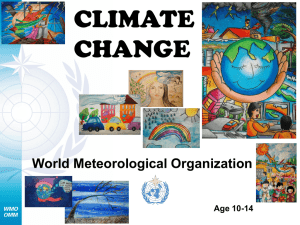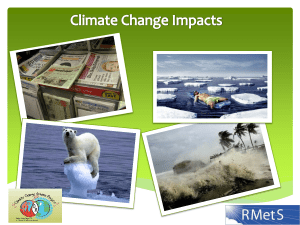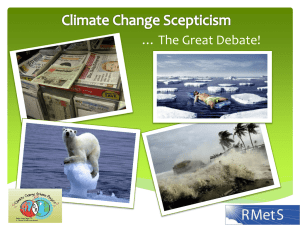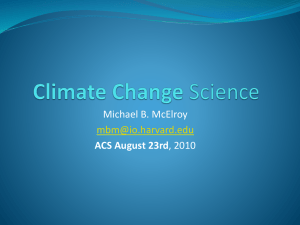Global_Climate_Change
advertisement
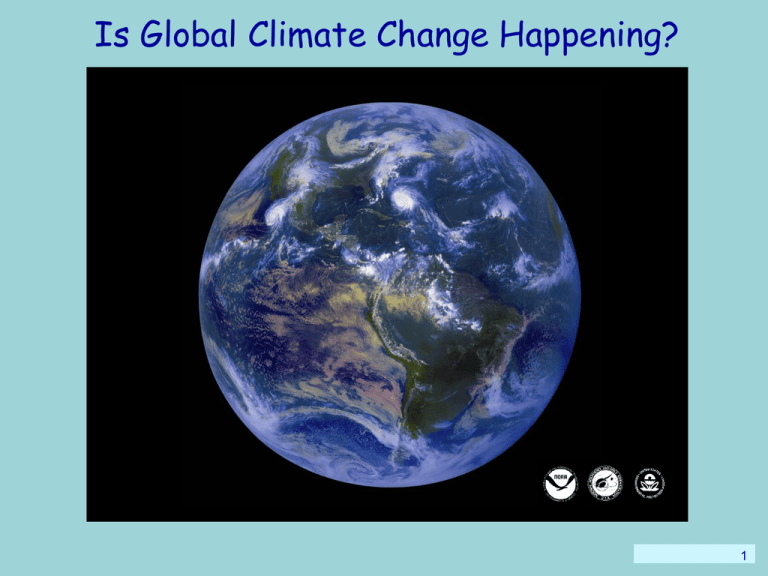
Is Global Climate Change Happening? 1 Weather vs Climate • Weather: atmospheric conditions in any given place over a short term. (i.e. Today will be dry and 95 degrees F) • Climate: average weather conditions in a region over a long period of time. (i.e. Dry season in the southwest) Global Warming or Climate Change? • Global Warming – Increase in the Earth’s average temperature (i.e. an increase of 1 degree F) • Global Climate Change – Change in average weather conditions in a region over a long period of time (i.e. increase or decrease; temperature, precipitation, humidity, storms) The Climate System System – A set of parts that interact or work with each other The climate system is affected by: NOAA Slides by Forecast Systems Laboratory. 3 Hydrosphere – all of Earth’s water (solid, gas & liquid). Oceans store and release Carbon Dioxide or CO2 Hydrosphere Distribution Cryosphere - all solid water; sea ice, glaciers – Albedo or reflect Sun’s energy http://www.google.com/imgres?imgurl=http://www.the-m-factory.com Biosphere: all life; trees & plants – use, store and release CO2 (carbon dioxide) http://www.google.com/imgres?imgurl=http://www.isavo.com Atmosphere – gaseous layer surrounding Earth – clouds exert a cooling effect that slows the evaporation of water http://www.google.com/imgres?imgurl=http://www.pacificislandtravel.com Anthrosphere – what humans build; we burn fossil fuels which releases CO2 The Greenhouse Effect • The sun’s energy enters the atmosphere and warms the Earth. Our planet’s atmosphere traps the heat energy. • Some of the sun’s energy is reflected back into space but the remainder is absorbed by greenhouse gases in the atmosphere where they help to warm the planet. 4 Without this natural phenomenon our planet would be 60 degrees F colder Living things need a temperature of 32-212°F (0-100°C) to survive . Greenhouse Gases: Carbon Dioxide http://www.google.com/imgres?imgurl=http://www.geos.ed.ac.uk Sources of carbon dioxide emissions are: Land plants use CO2 from the atmosphere and return it when they die Aquatic plants use CO2 from the water and return it when they die 5 Animal and plant respiration emits CO2 into the environment Burning of forests or fossil fuels emits CO2 to the atmosphere Oceans and forests are carbon sinks which take in more carbon than they release. Greenhouse Gases: Methane NOAA Slides by Forecast Systems Laboratory. 6 Greenhouse Gases: Methane • Most of the methane emissions are from landfills • Other sources are livestock and fossil fuel production http://www.google.com/imgres?imgurl=http://herbarium.usu.edu/fungi/funfacts/ Greenhouse Gases: Summary • The major greenhouse gas is CO2 but methane is more potent. • The other major gases are water vapor and nitrous oxide. 1996 Total U.S. Greenhouse Gas Emissions Hydroflourocarbons (HFCs), perflourocarbons (PFCs), and Sulfur hexaflouride (SF6) Nitrous Oxide 1.9% 5.8% 10.0% Methane 82.3% Carbon Dioxide Source: Inventory of U.S. Greenhouse Gas Emissions and Sinks: 1990 - 1996. U.S. EPA publication #236-R-98-006 7 Atmospheric Concentrations of CO2 Mauna Loa, Hawaii 1959-1992 Annual Concentrations of CO2 Z (ppmv) 360 350 340 330 320 310 300 290 Years Source: Trends’93 A Compendium of Data on Global Change, Oak Ridge National Laboratory, Publication no. ORNL/CDIAC-65. Mauna Loa data from C.D. Keeling and T. Whorf 8 Ozone depletion vs. Greenhouse Effect • Ozone depletion is caused by the release of CFC’s (chlorofluoro-carbons) which break down the ozone layer. • The ozone layer protects us from harmful radiation and gamma rays from the sun. • Climate change due to the increasing amount of greenhouse gases is a different problem than ozone depletion. How Do We Take the Earth’s Temperature? Weather stations track temperature, rainfall/precipitation, wind speed, and barometric pressure on land. Ocean buoys take measurements at sea. Satellites and weather balloons take measurements in the lower atmosphere. 14 http://www.google.com/imgres?imgurl=http://earthobservatory.nasa.gov Air bubbles in ice core samples provide information of the air composition (CO2) and temperature throughout Earth’s past. CO2 measurements from the ice cores at the South Pole over 1000 years and direct measurements in Hawaii over 150 years 12 Global temperatures are increasing NOAA Slides by Forecast Systems Laboratory. 10 Climate Models - Climate change is a natural process; periods of colder and warmer climates • Ice age 6 degrees F colder • Land ice melts, rise in sea levels, mass extinctions 6 degrees F warmer Scientists predict the earth will warm an additional 2-6 degrees F by the year 2100 How Humans Influence Climate Models • Scientists suggest that humans are influencing global climate change due to data that population increases match the increases in greenhouse gases. NOAA Slides by Forecast Systems Laboratory. 11 Climate Change Evidence 1. Atmospheric gases of CO2, N2O, Methane and Water Vapor are increasing at a rapid rate. 2. Global temperature has increased by 1 degree F in the past century. Weird Weather: Global Warming 20 3. Extreme weather; more frequent hurricanes, droughts, and floods. • El Nino refers to above normal surface temperatures in the Pacific Ocean that cause easterly winds to weaken. The cold water is unable to rise to the surface of the ocean. This interaction affects weather around the world, Australia experiences droughts while USA and Peru experience floods. • La Nina is below normal sea surface temperatures. 4. Land and sea ice are melting – decreasing Albedo • Ocean levels are rising, (melting land ice) submerging islands and eroding land. • Salt water invades (salinity rates) and changes the fresh water ecosystems. • Warm water holds less oxygen which can suffocate organisms or organisms migrate disrupting the food web for other organisms. WHY? • The warmer water prevents mixing of nutrients and organisms found in colder waters. This is referred to as an “ocean desert” and in total is the size of Asia. • The warm water also can shut down the ocean conveyor system which cycles water on our planet. 5. Changes in biome boundaries or disappearance of habitats; i.e. forests disappearing impacts variety of species, tundra permafrost, coral bleaching 6. Impacts on organisms; extinction rates increase changes too fast for plants and animals to adapt, different migrating or nesting patterns 7. Increase in disease carrying mosquitoes in once colder areas 8. Economic effects – damages from sea level rise or severe storms Are Humans Changing the Climate? Similarities between temperature and CO2 levels NOAA Slides by Forecast Systems Laboratory. 18 U.S. Emissions Each year, each person in the USA adds 20 tons of CO2 to the atmosphere (roughly the mass of 4 elephants or 40,000 pounds) NOAA Slides by Forecast Systems Laboratory. 24 USA is the leading producer of CO2 CO2 Emissions From Fossil Fuel Combustion: 1996 Million Tonnes of CO2 6000 5000 4000 3000 2000 1000 Af ric a co ut h So M ex i a na d in g K Ca m do ia In d Un ite d n Ge rm an y pa Ja Pe op Un ite d le' St sR at es ep .O fC hi na Ru ss ia 0 Source: CO2 Emissions from Fuel Combustion 1971 - 1996, International Energy Agency, page II.4-5, 1998 Edition 22 CO2 Emissions Per Person: 1996 Million Tonnes of CO2 25 20 15 10 5 0 Source: CO2 Emissions from Fuel Combustion 1971 - 1996, International Energy Agency, page II.53-55, 1998 Edition 23 Human activities that contribute greenhouse gases to the atmosphere: Electricity-burn fossil fuels Transportation – burn fossil fuels Cutting and burning forests NOAA Slides by Forecast Systems Laboratory. 21 Increase in human population/demand Waste in landfills Livestock waste Why Should We Care? 26 What Can We Do About Global Climate Change? 27 What Can We Do About Climate Change? Reduce, Reuse, Recycle Public Transportation, Efficient Cars, Carpool, Bike, Walk Plant trees and Preserve Forests Conserve electricity, turn off appliances & lights when not in use Use renewable sources of energy Buy local products Use fluorescent light bulbs Use Energy Star Products – Appliances, Windows, Heating/Cooling Review: Matching • Global Warming • Global Climate Change • Greenhouse gases • Absorb sun’s energy and emit energy in our atmosphere • Change in average weather conditions in a region over a long period of time • Increase in the Earth’s average temperature Review: Matching •Atmosphere •Biosphere •Anthrosphere •Hydrosphere • Human construction (everything we build) • Includes all of the water on the Earth • All life on Earth • The gaseous layer that surrounds the Earth Which 2 factors are the largest contributors to GCC? • • • • • • • Burning Forests Landfills Ozone Depletion Burning Fossil Fuels Farming Industry Breathing What happens with warm temps? Oceans • Ice • Levels • Oxygen • Molecules • Albedo • Light changes





